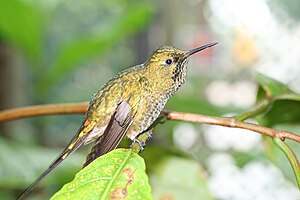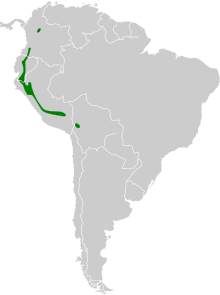Green-tailed sylph
| Green-tailed sylph | ||||||||||
|---|---|---|---|---|---|---|---|---|---|---|

Green-tailed sylph |
||||||||||
| Systematics | ||||||||||
|
||||||||||
| Scientific name | ||||||||||
| Lesbia nuna | ||||||||||
| ( Lesson, RP , 1832) |
The green- tailed sylph ( Lesbia nuna ) or sometimes the green-tailed lesbia is a species of bird from the hummingbird family (Trochilidae). The species has a large range that includes the South American countries Venezuela , Colombia , Ecuador , Peru and Bolivia . The IUCN classifies the population as “not at risk” ( least concern ).
features
The green-tailed sylph reaches a body length of 11–16 cm, depending on the subspecies, with the small straight beak between 0.7 and 1.4 cm. Their extremely long forked tail with narrow transverse bands varies in length from 5.5 cm in young animals to 10 cm in the northern subspecies. In the nominate form, the tail is about 12 cm long. It differs from the black-tailed sylph by its less pronounced tail and the intense emerald-green tail and rump feathers remote from the body. This glittering green is just as pronounced on the throat and decreases towards the mid-chest. The cesspool is streaked with green. Most of the plumage shimmers green.
behavior
Their behavior is extremely aggressive, but submissive to the black-tailed sylph. She gets her nectar from buddleia , castilleja , quiver flowers , rubus and other plants. Occasionally she goes looking for insects.
Reproduction
Their courtship behavior differs from the black-tailed sylph. For this purpose the males fly in a zig zag in front of the seated female. In the Quito area, green-tailed sylph nests have been observed from November to April.
Vocalizations
Her reputation is described as very lively bssst .
distribution and habitat
The green-tailed sylph occurs at altitudes between 1700 and 3800 meters. In Colombia you can find them in the Departamento de Boyacá and Cundinamarca as well as the east of Colombia. It continues over the central Andes of the Departamento del Cauca and the eastern slopes of the Departamento de Nariño to the south of Ecuador. They can also be found in northern Peru on both sides of the Marañón Valley to the north of the Lima region and its western Andean slopes. Further populations can be found in the Huánuco region in central Peru, as well as the Andean valleys from Huancavelica and Cusco via the Mapiri Canyon to the humid areas near Charazani .
Subspecies
There are six known subspecies:
- Lesbia nuna gouldii ( Loddiges , 1832) - This subspecies is found in Colombia and western Venezuela. However, there is only one report from Mérida in northwestern Venezuela, so that Venezuela is questionable as a distribution area.
- Lesbia nuna gracilis ( Gould , 1846) - This subspecies is common in the northern and central parts of Ecuador.
- Lesbia nuna aureliae Weller & Schuchmann , 2004 - This subspecies is common in southern Ecuador .
- Lesbia nuna pallidiventris ( Simon , 1902) - This subspecies occurs in northern Peru.
- Lesbia nuna huallagae Weller & Schuchmann , 2004 - This subspecies occurs in central Peru.
- Lesbia nuna nuna ( Lesson, RP , 1832) - The nominate form occurs in southwestern Peru and in northern Bolivia.
The Lesbia nuna eucharis ( Bourcier & Mulsant , 1848), long regarded as a further subspecies, is now seen as a hybrid between green-tailed sylph and black-tailed sylph.
Etymology and history of research
René Primevère Lesson described the green-tailed sylph under the name Ornismya nuna . He had two copies of Emmanuel Jacques Canivet (1796-1849) available, which he had from Peru. In 1833 Lesson introduced the genus Lesbia for the green- tailed sylph and the golden-tailed sylph ( Sappho sparganurus sapho (Lesson, 1829)). This word is derived from the Greek »Lesbias λεσβιας « for »women from Lesbos«. The species name is dedicated to Nouna-Koali, an Indian virgin from the novella Ismaël Ben Kaïzar ou la découverture du Nouveau Monde by Ferdinand Jean Denis (1798–1890). "Gouldii" is a dedication for John Gould from whose collection the type specimen came. "Gracilis, gracilus" is Latin for "slim, shapely, thin". »Pallidiventris« is a Latin word structure from »pallidus, pallere« for »pale, pale« and »venter, ventris« for »belly, bellied«. »Huallagae« refers to the biogeographical center of this subspecies, the upper reaches of the Río Huallaga . "Aureliae" refers to the Latin word "aureolus, aureus, aurum" for "golden, gold" and is intended to emphasize the clearer golden-bronze tint of this subspecies. "Eucharis" is of Greek origin and is derived from "eu, ευ " for "fine" and "charis, charitos, χαρις, χαριτος " for "grace, grace, beauty".
literature
- Jon Fjeldså , Niels Krabbe : Birds of the High Andes: A Manual to the Birds of the Temperate Zone of the Andes and Patagonia, South America . Apollo Books, Stenstrup 1990, ISBN 978-87-88757-16-3 .
- René Primevère Lesson : Histoire naturelle des colibris: suivie d'un supplément à l'Histoire naturelle des oiseaux-mouches: ouvrage orné de planches dessinées et gravées par les meilleurs artistes: et dédié AM le Baron Cuvier 66 plates (Prêtre, Antoine Germ ) . Arthus-Bertrand, Paris ( biodiversitylibrary.org - 1830-1832).
- René-Primevère Lesson: Les trochilidées ou Les colibris et les oiseaux-mouches: suivis d'un index général, dans lequel sont décrites et classées méthodiquement toutes les races et espèces du genre trochilus . Delivery 12. A. Bertrand, Paris 1833 ( biodiversitylibrary.org ).
- Jules Bourcier, Étienne Mulsant: Description of the quelques nouvelles espèces d'oiseaux-mouches . In: Revue zoologique par la Société cuviérienne . 1848, p. 269-275 ( biodiversitylibrary.org ).
- George Loddiges: Specimens were exhibited of several Humming Birds from Popayan, forming part of the collection of Mr John Gould; and the following characters . In: Proceedings of the Committee of Science and Correspondence of the Zoological Society of London . tape 2 , 1832, p. 6-7 ( biodiversitylibrary.org ).
- John Gould: On twenty new species of Trochilidae or Humming-birds . In: Proceedings of the Zoological Society of London . tape 21 , no. 164 , 1846, pp. 85-90 ( biodiversitylibrary.org ).
- Eugène Simon: Étude sur les Trochilidés observés an Perou par GA Baer (1900-1901) . In: Novitates Zoologicae . tape 9 , 1902, pp. 177-183 ( biodiversitylibrary.org ).
- André-Alexander Weller , Karl-Ludwig Schuchmann : Biogeographic and taxonomic revision of the trainbearers Lesbia (Trochilidae), with the description of two new subspecies . In: Ornithological Indicator . tape 43 , no. 2 , 2004, p. 115-136 ( PDF on ZOBODAT ).
Web links
- Lesbia nuna inthe IUCN Red List of Threatened Species 2017.1. Listed by: BirdLife International, 2016. Retrieved August 24, 2017.
- BirdLife International: Species Factsheet - Green-tailed Trainbearer ( Lesbia nuna ) . Retrieved August 24, 2017.
- Videos, photos and sound recordings of Green-tailed Trainbearer (Lesbia nuna) in the Internet Bird Collection
- Green-tailed sylph ( Lesbia victoriae ) at Avibase; accessed on August 24, 2017.
- Lesbia nuna in the Integrated Taxonomic Information System (ITIS). Retrieved August 20, 2017.
- xeno-canto: Sound recordings - Green-tailed Trainbearer ( Lesbia nuna )
- Green- tailed sylph (Lesbia nuna) in the Encyclopedia of Life . Retrieved on August 24, 2017.
Individual evidence
- ↑ a b c d e f Jon Fjeldså u. a., p. 278.
- ^ IOC World Bird List Hummingbirds
- ↑ George Loddiges, p. 7.
- ^ John Gould, p. 86.
- ↑ a b c André-Alexander Weller u. a., p. 128.
- ↑ Eugène Simon, p. 182.
- ^ André-Alexander Weller u. a., p. 127.
- ↑ a b c René Primevère Lesson (1832), p. 169, plate 35.
- ↑ Jules Bourcier et al. a., p. 274.
- ↑ René Primevère Lesson, p. 170.
- ^ René Primevère Lesson (1833), p. Xvij.
- ↑ James A. Jobling p. 222
- ↑ George Loddiges, p. 6.
- ↑ James A. Jobling p. 176
- ↑ James A. Jobling p. 289
- ↑ James A. Jobling, p. 151.
